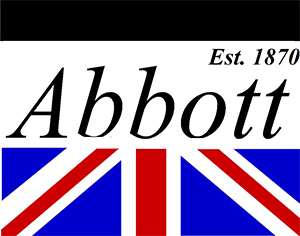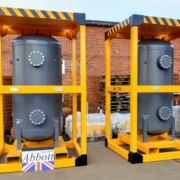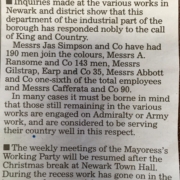An Inspector Calls
Ahh JB Priestly I hear you say ! .. Alas no, here at Abbotts the inspector tends to be from an insurance company or classification society – today our inspector is Steve Dickson (LHS) from BV – Bureau Veritas ! Seen below inspecting a vessel or two:
And the hot topic today is ‘bilge’ (yes – no change there then !)
Abbott Vessels with BV (Bureau Veritas) Inspection for Bilge Water Treatment – cleaning water from within ships in order to prevent damage to marine life -actually a very good thing.
Since 1828, BV’s mission has been to safeguard both wider global interests and the needs of its clients in terms of safety, security and environmental protection. This is achieved by developing, controlling and applying both BV and international standards in the design, Construction and maintenance of ships and marine equipment.
Abbotts has the design and build capability to manufacture BV air receivers, BV pressure vessels, and BV Hydrophores for theses applications on ships.
WE ALSO HAVE A RANGE OF STANDARD EXPANSION TANKS AIR RECEIVERS and other
PRESSURE VESSELS WITH RUBBER MEMBRANES
Most of the following is for Google, because despite paying less tax than most, it does know how to give search results … Read on at your own risk.,,
Further Reading for the brave regarding current legislation on Bilge Water in Ships etc……….
BV is a member of The International Association of classification societies.
Abbots can manufacture to meet the reqiuirements of the majority of these
societies – email enquiries for accumulatoras pressure vessels and expansion
vessels to info@abbottpressurevessels.co.uk
IACS consists of 12 member societies, details of which are listed below.
Chairmanship of IACS is on a rotational basis with each member society
Abbott Vessels with BV (Bureau Veritas) Inspection for Bilge Water Treatment
Abbotts has the design and build capability to manufacture BV air receivers,
BV pressure vessels, and BV Hydrophores for theses applications on ships.
WE ALSO HAVE A RANGE OF STANDARD EXPANSION TANKS AIR RECEIVERS and other PRESSURE VESSELS WITH RUBBER MEMBRANES
Further Reading for the brave regarding current legislation on Bilge Water in Ships etc……….
BV is a member of The International Association of classification societies. IACS
Abbots can manufacture to meet the reqiuirements of the majority of the IACS society member rules – email enquiries for accumulatoras pressure vessels and expansion vessels to info@abbottpressurevessels.co.uk
IACS consists of 12 member societies, details of which are listed below.
Chairmanship of IACS is on a rotational basis with each member society
taking a turn.
ABS www.eagle.org
BV – Bureau Veritas www.veristar.com
CCS – China Classification Society www.ccs.org.cn/ccswzen/
CRS – CROATIAN REGISTER OF SHIPPING www.crs.hr
DNV GL – Det Norske Veritas Germanisher Lloyds www.dnvgl.com
IRS – Indian Register of Shipping www.irclass.org
KR www.krs.co.kr
LR www.lr.org
NK www.classnk.or.jp
PRS – Polish Register of Shipping www.prs.pl
RINA www.rina.org
RS – Russian MAritime Register of Shipping www.rs-class.org/en/
Discharge of bilge water on vessels is a normal part of operations. However, discharge of mineral oil as part of the bilge water is generally undesirable since this oil contains numerous organic compounds – most of which are not easily biologically degradable. Since this is generally considered to be hazardous to the environment and health, many ships have an oily water separator installed to clean bilge
water before discharge. However, more often than not the separator performs to required standards only if it was recently cleaned and in perfect trim. And even then, the oily water separator has problems dealing with the oil content.
The International Maritime Organisation (IMO) stipulates a maximum of 15 ppm for bilge water discharged into open waters
Uniform Application of MARPOL Annex I,
Revised Regulation 12
1. History of Revised Regulation 12 of MARPOL Annex
– Following an increase in the number of prosecutions due to MARPOL Annex I
sludge tank related issues, at MEPC 55 in October 2006 commenced a review of MARPOL
Annex I Regulation 12.
– A correspondence group looked into all sludge tank issues including Oil Record Books, IBTS and plan approval, reporting to DE 51 through paper DE 51/18/1.
– DE 51 reviewed the CG report and a new Regulation 12.1bis was introduced
to further define sludge tanks.
– This was discussed at MEPC 58 where Regulation 12 was again reviewed and
amended, Regulation 12.1bis becoming Regulation 12.2. MEPC.1/Circs 641 and
642 were also issued. – MEPC 59 f
Det Norske Veritas (DNV) of Norway requires bilge separators to be equipped with a 5 ppm bilge alarm to fulfill the DNV Guidance for Clean Design (DNV, 2005).
Abbott pressure vessels and hydrophore tanks can also be built with DNV approved vessels & LR approval.
2008 REVISED GUIDELINES FOR SYSTEMS FOR HANDLING OILY WASTES IN
MACHINERY SPACES OF SHIPS INCORPORATING GUIDANCE
NOTES FOR AN INTEGRATED BILGE WATER TREATMENT SYSTEM (IBTS)
1 MARPOL Annex I contains certain regulations and unified interpretations related to equipment for the storage, handling and disposal of oily residues (sludge) and engine-room oily bilge water.
2 In order to facilitate the work of Administrations on systems for handling oily wastes in machinery spaces of ships, the Marine Environment Protection Committee (MEPC) has continuously reviewed the available technologies for fulfilment of the Convention requirements.
3 The Revised Guidelines for systems for handling oily wastes in machinery spaces of ships incorporating guidance notes for an integrated bilge water system (IBTS) appended to MEPC.1/Circ.511 were adopted by MEPC 54 as guidance for Administrations, shipowners and shipbuilders for consideration in achieving an efficient and effective system for the handling of oily bilge water and oily residues for ships taking into account the entry into force of the revised MARPOL Annex I on 1 January 2007.
4 Recognizing that the entry into force of MARPOL Annex VI, including its provisions for shipboard incineration of sludge oil generated during the normal operation of a ship, has called for a further revision of the Guidelines, as contained in MEPC.1/Circ.511, the
Marine Environment
Protection Committee, at its fifty-eighth session (6 to 10 October 2008), approved the 2008 Revised
Guidelines for systems for handling oily wastes in machinery spaces of ships incorporating Guidance notes for an integrated bilge water treatment system (IBTS) (MEPC 58/23,
paragraph 10.45).
The 2008 Revised Guidelines, set out in the annex, supersede and replace the
Revised Guidelines
appended to MEPC.1/Circ.511.
5 To ensure compliance with the provisions on oil residue (sludge) collection and disposal of
MARPOL Annex I, the process of regeneration of fuel oil from oil residue (sludge) has been defined and included in the Guidance notes for an integrated bilge water system
(IBTS) appended to the
Guidelines.
6 A recommendation regarding internal drain tanks for oily residue (sludge)and other oily residues, which can only be discharged to the vessel‘s oily residue (sludge)tanks has been included in order to simplify the required records in the Oil Record Book.
7 Member Governments are invited to apply the revised Guidelines and to bring them to the attention of interested parties, including recognized organizations.
I:\CIRC\MEPC\01\642.DOC
MEPC.1/Circ.642 in addition to the installations required by the Convention, the following installations should form
5.1.3 Independent drainage arrangements for oil and water to sludge tanks and the bilge waterholding tank should also be provided. Any open water drain in the engine-room falls under the definition of oily bilge water from engine-rooms. Such water shall be disposed ashore or via an oily water separator overboard.
5.1.4 Independent drainage of clean water drains from equipment not normally containing oil should be to clean water tanks.
5.2 Pre-treatment unit for oil separation Pre-treatment may take place in dedicated equipment or bilge primary tanks.
A bilge primary tank is a tank which separates oil from oily bilge water be gravity. It may make use of a cascade with drainage facilities for the oil on the top so as to enable primary separation of oily bilge water. Facilities to remove sediments should be provided. Refer to the example of a bilge primary tank shown in Figure 1.
From bilge pump To bilge water holding tank To oil residue (sludge) holding tank
Figure 1 œ Example of a bilge primary tank
5.3 Storage tanks
5.3.1 Clean drain tank: Tank for the retention of clean drains.
5.3.2 Oily bilge water holding tank: Tank for the retention of oily bilge water.
5.3.3 Oil residue (sludge) service tanks: Tank for preparation of oil residue (sludge) for incineration.
I:\CIRC\MEPC\01\642.doc
MEPC.1/Circ.642
ANNEX
Page 11
5.4 Discharge arrangement of clean drains
The overboard discharge arrangement of clean drains should be independent from the system for oily bilge water. Cleaning of equipment having clean drains should take account of the proper handling of chemical cleaning agents (e.g., emulsifiers) and wash water residue (including soot and sooty oil).
The cleaning agent/wash water residue can foul an oil filtration system and should therefore be subjected to separate collection and/or filtration (e.g., portable units).
5.5 Exclusive pump for the oily water separator
It is preferable that an exclusive pump be provided to transfer the pre-treated bilge water from the oily bilge water holding tank to the oily water separator so as not to mix the pre-treated bilge water with untreated oily bilge water.
5.6 Heating arrangement
5.6.1 Heating arrangement for the bilge primary tank to facilitate separation of oil.
5.6.2 Heating arrangement for the waste oil tank to vaporize water and facilitate incineration.
6 Example of IBTS




Leave a Reply
Want to join the discussion?Feel free to contribute!